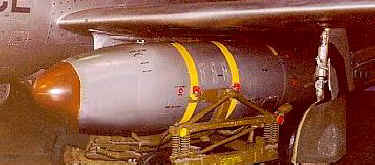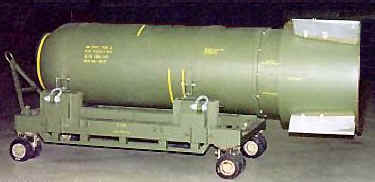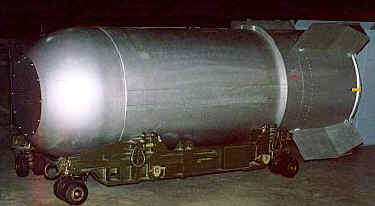 |
Mk-
7 Nuclear Bomb
Initially produced in 1952, the Mark 7 was the first nuclear weapon
which could be carried by fighters. Although they
carried it externally, it could also be
carried internally by bombers such as the B-57. Capable of either an air or ground detonation, the Mk-7 had a yield
in the kiloton range. It became obsolete in 1967 and is no longer in service |
 |
Mk-28
Nuclear Bomb
This "hydrogen" bomb was first produced in 1958 and is still seeing
active service. It was designed to be carried by various fighter and bomber
aircraft. The "28" warhead was also
used in Hound dog and Mace missiles which are now retired.
This weapon is capable of a ground or air burst and may be carried internally or
externally, with a free-fall or parachute retarded drop, depending upon its
configuration |
 |
Mk-39
Nuclear Bomb
An improved Mk-15 that came into service in 1957. It was carried by B-47 and B-52
bombers. It featured a shock-absorbing aluminum
honeycomb nose and used four parachutes for retarded deliveries.
The Mk-39 weighed 10,000 pounds and had an explosive yield measured in
megatons. The last one was removed from service in 1966. |
 |
Mk-53
Nuclear Bomb
First produced in 1962, it was designed to be carried
internally by B-47, B-52, B-58, and B-70
aircraft. It was equipped with five parachutes to retard delivery. If for some reason a
free-fall
delivery was required, the parachute "can" could have been blown out,
thereby jettisoning all chutes. With a yield in the megaton range. they
can be configured for air burst, contact burst, and delayed action
detonation. The Mk-6 re-entry vehicle installed on the Titan II ICBM
contained a W53 warhead, basically the same as the Mk-53 bomber version.
|
|
